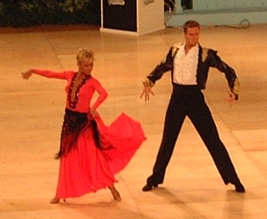|

Paso Doble
Musicality:
The time signature
of the music used for this dance is 2/4. There are no percussive accents in
Paso Doble, however a musical accent occurs on the 1st beat of each bar. The
dance should be started on the 1st beat of a musical phrase.
The tempo of the
dance is 60-62 bars per minute.
Phrasing/Method of Counting:
Most Paso Doble
music is written in 2/4 time, therefore there are two beats for every bar of
music.
The timing of a
figure containing a multiple number of steps, each using one beat of music, is
1.2.1.2.1.2. etc. Because some figures contain many steps, the use of this
timing becomes unnecessarily complicated.
This difficulty
can be overcome by counting each group of 4 or 8 steps separately, using the
numerical count of 1234 or 12345678. The numerical count also offers
considerable advantage when grouping figures or parts of figures to form
routines that will maintain harmony with the musical phrasing.
It is desirable,
and more pleasurable, for each figure or group of movements to commence at
the beginning of a musical phrase. This is achieved by choosing the correct
following figure to suit the phrasing required, and by the limited use of
figures such as Sur Place, Basic Movements, and Chasses.
Posture and Poise:
Stand with feet
together, the knees straight but not locked (Lady, knees very slightly
flexed). With the weight forward over the balls of the feet, pull the abdomen up and in
and tighten the buttocks to avoid an arched back. Lift the rib cage to
elongate the spine; the chest should be held forward with a feeling of
pride, and the shoulders are down and back with the shoulder blades held
firmly. By pulling down the shoulder blades, the neck lengthens and
gives a good balanced line to the head. The Man has a straighter line in the
back, the Lady in contrast a curve. There must be strength throughout the
Man's posture, always dominating his partner.
This posture
should be sustained throughout the dance. A sideways shape is required in
some figures, which is developed from the waist. If the shape is to the right,
then the left side is well stretched and vice versa.
Hold:
Stand about 6
inches apart. Lady is held slightly on Man's right side. The Man's right
hand is placed on the Lady's left shoulder blade and the Lady's left arm
rests lightly on his right arm, following the curve of his arm to the
shoulder. The Man's left hand is raised in a gentle curve to the level of
the eyes. The Lady's right hand is placed in the Man's left hand with her
fingers between his thumb and first finger. The hands are lightly clasped.
|
Appel:
The Appel is an
action frequently used as the first step of a figure to indicate a change in
movement and it depicts the Matador's call to the bull.
Commence from
Close Hold but with pelvis rotated to R (Lady L); stand with feet together, on toes,
with weight on LF (Lady RF). The Appel consists of a strong lowering through the
RF and leg accompanied by the appropriate lead for the figure to be danced.
The footwork is B flat.
The track of the
man's L arm is when moving from an Appel to Promenade Position is to lower
arm to chest level and rotate L wrist to R (clockwise) to indicate turn and
change of shape to Promenade Position, commenced during preceding beat of
music.
The Appel can be
syncopated to take only
1/2
beat of music during the first beat of a bar (counted as &). The following
step will then have a beat value of 11/2
(counted as
1.2). You can use a syncopated Appel in the following figures: Separation,
Sixteen, Twist Turn, Promenade, Promenade to Counter Promenade, La Passe,
and Syncopated Separation.
Paso Doble Closed Syllabus
Newcomer:
1.
Sur Place
2.
Basic Movement
3.
Chasses to
Right or Left
4.
Drag
5.
Deplacement
(Attack)
6.
Promenade Link
(Promenade Close)
7.
Promenade
8.
Ecart (Fallaway
Whisk)
9.
Separation
10.
Separation
with Lady's Caping Walks
Bronze:
1. Fallaway Ending
to Separation
2. Huit
3. Sixteen
4. Promenade and
Counter Promenade
5. Grand Circle
6. Open Telemark
Silver:
1. La Passe
2. Banderillas
3. Twist Turn
4. Fallaway
Reverse Turn
5. Coup de Pique
6. Left Foot
Variation
7. Spanish Lines
8. Flamenco Taps
Gold:
1. Syncopated
Separation
2. Traveling Spins
from Promenade Position
3. Traveling Spins
from Counter Promenade Position
4. Twists
5. Chasse Cape
(including Outside Turn)
Click on any figure for detailed description!
Paso Doble Choreography Demonstrations
Silver Paso Doble:
|

